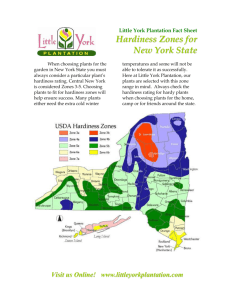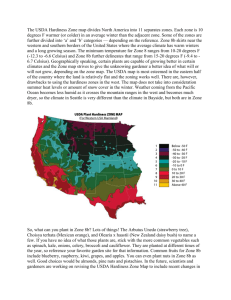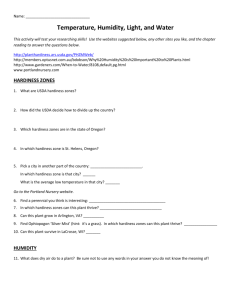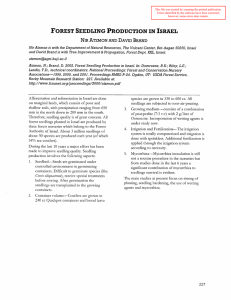Seedling Phenology and Cold Hardiness: Moving Targets Diane L Haase
advertisement
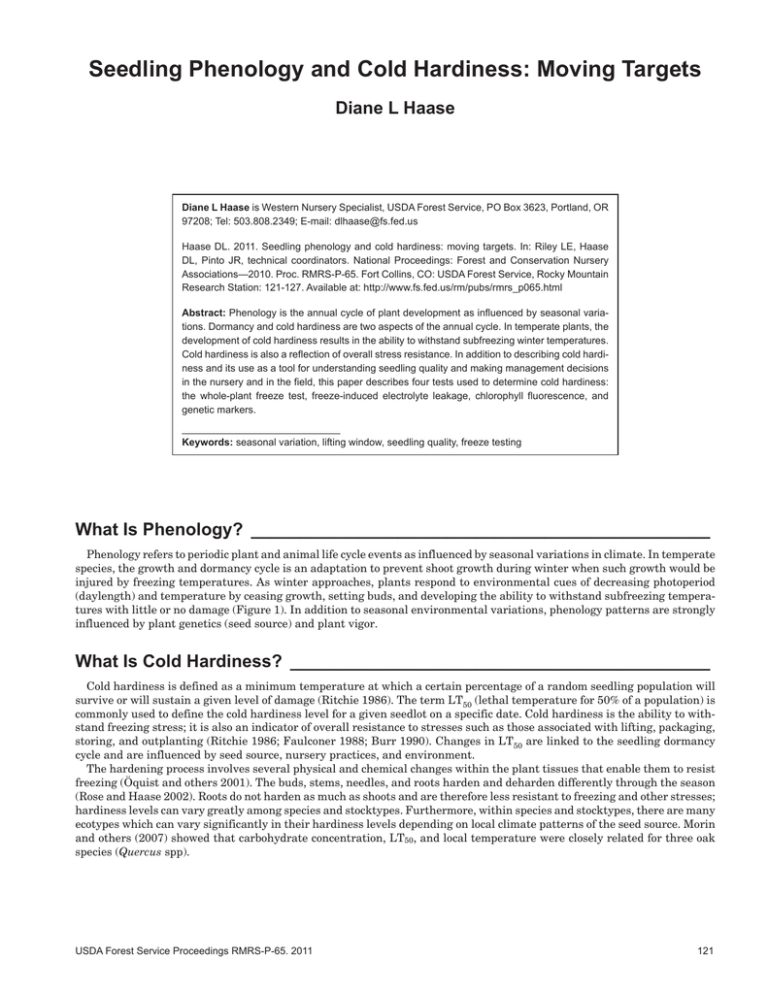
Seedling Phenology and Cold Hardiness: Moving Targets Diane L Haase Diane L Haase is Western Nursery Specialist, USDA Forest Service, PO Box 3623, Portland, OR 97208; Tel: 503.808.2349; E-mail: dlhaase@fs.fed.us Haase DL. 2011. Seedling phenology and cold hardiness: moving targets. In: Riley LE, Haase DL, Pinto JR, technical coordinators. National Proceedings: Forest and Conservation Nursery Associations—2010. Proc. RMRS-P-65. Fort Collins, CO: USDA Forest Service, Rocky Mountain Research Station: 121-127. Available at: http://www.fs.fed.us/rm/pubs/rmrs_p065.html Abstract: Phenology is the annual cycle of plant development as influenced by seasonal variations. Dormancy and cold hardiness are two aspects of the annual cycle. In temperate plants, the development of cold hardiness results in the ability to withstand subfreezing winter temperatures. Cold hardiness is also a reflection of overall stress resistance. In addition to describing cold hardiness and its use as a tool for understanding seedling quality and making management decisions in the nursery and in the field, this paper describes four tests used to determine cold hardiness: the whole-plant freeze test, freeze-induced electrolyte leakage, chlorophyll fluorescence, and genetic markers. Keywords: seasonal variation, lifting window, seedling quality, freeze testing What Is Phenology?________________________________________________ Phenology refers to periodic plant and animal life cycle events as influenced by seasonal variations in climate. In temperate species, the growth and dormancy cycle is an adaptation to prevent shoot growth during winter when such growth would be injured by freezing temperatures. As winter approaches, plants respond to environmental cues of decreasing photoperiod (daylength) and temperature by ceasing growth, setting buds, and developing the ability to withstand subfreezing temperatures with little or no damage (Figure 1). In addition to seasonal environmental variations, phenology patterns are strongly influenced by plant genetics (seed source) and plant vigor. What Is Cold Hardiness?____________________________________________ Cold hardiness is defined as a minimum temperature at which a certain percentage of a random seedling population will survive or will sustain a given level of damage (Ritchie 1986). The term LT50 (lethal temperature for 50% of a population) is commonly used to define the cold hardiness level for a given seedlot on a specific date. Cold hardiness is the ability to withstand freezing stress; it is also an indicator of overall resistance to stresses such as those associated with lifting, packaging, storing, and outplanting (Ritchie 1986; Faulconer 1988; Burr 1990). Changes in LT50 are linked to the seedling dormancy cycle and are influenced by seed source, nursery practices, and environment. The hardening process involves several physical and chemical changes within the plant tissues that enable them to resist freezing (Öquist and others 2001). The buds, stems, needles, and roots harden and deharden differently through the season (Rose and Haase 2002). Roots do not harden as much as shoots and are therefore less resistant to freezing and other stresses; hardiness levels can vary greatly among species and stocktypes. Furthermore, within species and stocktypes, there are many ecotypes which can vary significantly in their hardiness levels depending on local climate patterns of the seed source. Morin and others (2007) showed that carbohydrate concentration, LT50, and local temperature were closely related for three oak species (Quercus spp). USDA Forest Service Proceedings RMRS-P-65. 2011 121 Seedling Phenology and Cold Hardiness: Moving Targets Haase Figure 1. Typical phenological cycle for temperate zone plants. There is a common misperception that cold hardiness and bud dormancy reflect the same thing; deepest dormancy and maximum cold hardiness, however, do not occur at the same time. Bud dormancy is quantified by the length of time it takes for plants to resume growth in the spring. Once plants have entered rest in the fall (commonly October or November; Figure 1), they are at peak dormancy. In order to complete their dormancy cycle and resume growth in spring, seedlings require a period of chilling. The chilling requirement for Douglas-fir (Pseudotsuga menziesii Mirb. Franco) is 12 to 14 weeks (approximately 2000 hours). If not totally fulfilled at lifting, the chilling requirement may be met in cold storage (temperatures in freezer storage are considered below optimum for accumulation of chilling). On the other hand, cold hardiness continues to develop through the fall and reaches a maximum in winter (Figure 2). In the Pacific Northwest, conifer species tend to have maximum hardiness in January. As spring approaches, cold hardiness is quickly lost in response to longer photoperiods and warmer temperatures. Figure 2. Cold hardiness (LT50) and stress resistance are correlated, whereas dormancy intensity (days to budbreak) declines throughout the winter. 122 USDA Forest Service Proceedings RMRS-P-65. 2011 Haase Seedling Phenology and Cold Hardiness: Moving Targets How is Cold Hardiness Measured?_____________________ The Whole-Plant Freeze Test The whole-plant freeze test (WPFT) is the most common technique used to estimate cold hardiness. Unlike other available cold hardiness tests, WPFT is a simulation of an actual freeze event and takes the entire shoot into account. In this test, the entire seedling is potted, placed in a programmable freezer, and exposed to controlled, sub-freezing temperatures. After freezing, seedlings are placed in optimum growing conditions for 6 to 7 days, and then assessed for damage to the shoot tissues in order to quantify mortality at a given temperature (Tanaka and others 1997). The LT50 is then determined by plotting survival percentage against temperature and assuming a linear relationship. Below are the WPFT steps in detail: 1. A minimum of 60 seedlings of a specific seed source and stocktype are randomly selected so that they provide good representation of the entire lot. The test should commence within 48 hours of sampling in order to accurately assess cold hardiness on the given sample date. If seedlings are to be shipped or stored prior to the test, they should be kept in cool conditions (1 to 3 °C [34 to 38°F]). 2. The seedlings are randomly divided into four groups with 15 (or more) seedlings in each group. Each group of seedlings is potted into a light medium. Damp peat moss works best; high water content should be avoided because it will give off heat in the freezing chamber, thereby making it difficult to achieve target temperatures. Four-liter (1-gal) pots with five seedlings per pot works well. Large stocktypes (for example, plug+1) may have to be potted at 3 to 4 per pot, whereas very small stocktypes (for example, 1+0 bareroot seedlings or seedlings grown in Styroblock™ 4 containers [66 cm3 or 4 in3]) can be potted at 7 to 10 per pot. It is important that the seedlings be upright and spread apart in the pot. Roots should be completely covered by the medium and shoots should not be too deep (medium should just cover the cotyledon scar). Stems planted too deep will be insulated from the freezing temperatures and, therefore, that section of stem will not be available for damage assessment. Container seedling plugs should be completely covered by the medium. 3.Each group of seedlings is assigned to a freezing temperature. Each pot should be clearly labeled with durable tags to identify the lot information and test temperature. Four target temperatures are chosen based on their expected ability to bracket the LT50 for that specific sampling date. As seedlings harden or deharden throughout the season, warmer or colder temperatures are used. Each group of seedlings is placed into a programmable chest freezer. Temperature in the freezer is lowered from room temperature to 0 °C (32 °F) at 20 °C (36 °F) per hour, then decreased to the target temperature at 5 °C (9 °F) per hour, held at the target temperature for 2 hours, then raised back to 0 °C (32 °F) at 20 °C (36 °F) per hour, at which point they are removed from the freezer (Figure 3). 4. After freezing, seedlings are placed into a greenhouse or other holding area with ambient photoperiod and an average temperature of about 20°C (68°F). Pots should be watered thoroughly as soon as the medium thaws, and be kept moist. Plants are held in this area for 6 to 7 days to allow for any damage to become evident. Figure 3. Example of a whole-plant freeze test (WPFT) time sequence for a target temperature of -18 °C (0 °F). USDA Forest Service Proceedings RMRS-P-65. 2011 123 Seedling Phenology and Cold Hardiness: Moving Targets 5. After 6 to 7 days in the greenhouse or holding area, tissue damage is assessed on buds, cambium, and foliage as follows (see also Figure 4 for example data sheet): Bud damage is determined on 5 to 10 randomly selected buds from throughout each seedling shoot. Each bud is cut in half and examined for evidence of browning. Buds that are questionable should be counted as “half dead.” For example, if 8 buds are assessed and 4 are healthy (green), 2 are dead (clearly brown), and 2 are questionable (slight browning), then the final total would be 2 + ½ + ½ = 3 out of 8 are killed for that seedling. Haase Cambial damage is evaluated by scraping the bark along the stem and examining for browning or drying in each third of the shoot (bottom, middle, top). Each third is rated as 0 (dead), 1 (healthy), or 2 (questionable). Foliar damage is estimated visually as a percentage of brown or dry foliage. This can be done on an individual seedling basis or as an estimate of all seedlings in the group. Figure 4. Evaluation of tissue damage is used to estimate seedling mortality at a given temperature. 124 USDA Forest Service Proceedings RMRS-P-65. 2011 Haase Seedling Phenology and Cold Hardiness: Moving Targets 6. Mortality is determined based on the extent of damage. If the cambium is damaged in the lower or middle third of the shoot, or if greater than 50% of the buds are damaged, then the seedling is considered non-viable. Just like the cambium ratings, vitality is rated as 0 (dead), 1 (live), or 2 (questionable). The percentage of foliar damage is only a determining factor when cambium or bud damage is borderline. Questionable trees are counted as “half dead” for determining the total mortality. 7. The final step is to plot survival percentage for each of the test temperatures (Figure 5). Assuming a straight line relationship, the LT50 is the temperature corresponding to the point where 50% of the seedlings were estimated to have been killed (Tanaka and others 1997). Freeze-Induced Electrolyte Leakage Another method for measuring cold hardiness is the freeze-induced electrolyte leakage (FIEL) test. It measures the amount of electrolytes that leak out of cell membranes when they are damaged by freezing. In the FIEL test, electrolytes are measured using an electrical conductivity meter and used to estimate the amount of damage in specific plant tissues as a result of freezing (Burr and others 1990; McKay and Mason 1991; Folk and others 1999). FIEL measurements are expected to be highest when seedlings are actively growing, and lowest when they are dormant due to the plants ability to withstand intracellular freezing. For operational FIEL testing, tissue samples (for example, ten 1-cm [0.4-in] needle segments) are rinsed in distilled water (DI) and placed in vials. A small amount of DI is then added to each vial to prevent desiccation during freezing. Usually there are five to six sets of vials prepared (one set for each test temperature plus a control; there should be five to ten vials in each set). The control samples are placed in a refrigerator at 2 °C (36 °F). The samples designated for freezing are placed into a programmable freezer that is lowered from room temperature to 2 °C (36 °F) at 20°C (36 °F) per hour, and thereafter decreased at a rate of 5 °C (9 °F) per hour. When the chamber temperature reaches -2° C (28 °F), the vials are gently shaken to promote ice nucleation. Five pre-determined test temperatures are selected based on the expected hardiness of the samples. Upon reaching each test temperature as the freezer temperature is lowered, the samples designated for that test temperature are removed and placed in a refrigerator for thawing. Once all the vials are thawed, more DI is added to each vial to promote a diffusion gradient for the electrolytes and vials are shaken for 2 hours. Following shaking, each is measured for initial conductivity (EC1), then autoclaved at 120 °C (248 °F) for 20 minutes and allowed to cool at room temperature. The purpose of the autoclaving is to achieve 100% electrolyte leakage in the samples. Once cooled, vials are shaken again for 2 hours and conductivity is measured again to determine total electrolytes (EC2). Electrolyte leakage of samples from each test temperature is expressed as a percentage of total electrolytes (EC1/EC2). LT50 is derived by fitting the data set into nonlinear functions following a Gauss sigmoid model (Burr and others 1990). Figure 5. By plotting mortality at each whole-plant freeze test (WPFT) temperature, the LT50 can be determined (intersection of the 50% mortality estimate and freezing test temperature). USDA Forest Service Proceedings RMRS-P-65. 2011 125 Seedling Phenology and Cold Hardiness: Moving Targets Chlorophyll Fluorescence Chlorophyll exhibits a characteristic fluorescence pattern when photosynthetically active tissue is exposed to saturating light. The attributes of the fluorescence curve reflect the efficiency with which light energy can be processed. Chlorophyll fluorescence measurements can provide information about the overall photosynthetic condition of the plant and its responses to disturbances (Rose and Haase 2002). In species that grow in areas with extremely low winter temperatures, reversible photosynthetic inactivation in winter is an adaptive mechanism that provides protection against freezing damage. For these species, significant decreases in fluorescence can be measured and are associated with increases in freezing tolerance (Binder and Fielder 2006). On the other hand, coastal Douglas-fir and other temperate species exist in a geographic range that does not require complete photosynthetic inactivation for protection against winter cold. Mixed results have, therefore, been found regarding the relationship between chlorophyll fluorescence and cold hardiness. Chlorophyll fluorescence, however, has a good relationship with damage to tissues after exposure to freezing stresses (Rose and Haase 2002) and can be a useful tool for providing a rapid estimate of seedling vigor following freezing. There are an assortment of fluorometers on the market for measuring chlorophyll fluorescence, including both portable and laboratory models. Measurements are accomplished on a representative sample of foliar tissue that is either kept in ambient light so that chlorophyll are at a steady state (for determination of quantum photosynthetic yield) or dark-adapted for 20 to 30 minutes so that all chlorophyll are at a ground state (for determination of photochemical efficiency). The sample is placed into a specially designed clip or chamber and fluorescence data are generated following exposure to pulses of saturating light. Gene Expression This newly developed molecular test for assessing cold hardiness in conifer seedlings was developed by NSure, a spin-off company from Wageningen University in The Netherlands. The test is based on measuring the activity level of a carefully selected set of genes. The condition of any plant, animal, or microorganism is reflected in the activity profile of its genes; all physiological responses are initiated and directed by genes switching on or off. Gene expression analysis is used to detect the level of activity of specific genes in order to evaluate plant responses to environmental triggers. The NSure cold-tolerance assays were made available for Scots pine (Pinus sylvestris L.), Norway spruce (Picea abies L. Karst), and European beech (Fagus sylvatica L.) following research that demonstrated a correlation with gene activity and cold hardiness (Joosen and others 2006). NSure tests on Douglas-fir seedlings showed a good relationship with results generated using the WPFT method. The correlation was consistent for seedlots from both high and low elevations, provided buds were used for the gene profiling; when needles were used, however, the correlation was poor (Balk and others 2007). 126 Haase Do-It-Yourself Freeze Assessment Following a Freeze Event_________ Knowing the cold hardiness level of a given group of plants at a given time is useful in making management decisions for culturing, lifting, storage, and planting. The biggest question that invariably arises, however, is how to determine whether or not stock is damaged following an unexpected freeze event, such as unseasonably low temperatures or a malfunction with the storage or transportation cooler. Following a freeze event, plants may not show damage or mortality while still in the nursery or in storage because cool temperatures will slow the development of symptoms (much the same as produce kept in our home refrigerators remains fresh for a period of time even though it is no longer a living plant). The quick and easy way to determine if damage has occurred is to use some of the procedures from the WPFT: 1. Collect a random, representative sample of the affected stock (minimum 15 to 20 seedlings). 2. Pot seedlings (can be several per pot). 3. Place in a warm environment with ambient photoperiod (such as an office area); keep the medium moist. 4. Using a razor blade, evaluate the amount of browning in cambium and buds after 6 days. How Is Cold Hardiness Testing Used Operationally?__________________ In the Nursery Because cold hardiness is correlated with stress resistance, cold hardiness testing can yield data to help nursery growers make informed decisions regarding a specific seedling lot, especially those most vulnerable to freeze events. By knowing the hardiness level, growers can determine the need for frost protection, evaluate readiness for lift and storage, and estimate overall resistance to stresses incurred during handling. In a study with Douglas-fir and ponderosa pine (Pinus ponderosa Dougl. ex Laws.) seedlings, cold hardiness data was used to establish lifting windows that were shown to vary annually based on weather patterns and other factors (Tinus 1996). In addition, growers can track crop hardiness in response to dormancy induction treatments or other culturing activities. Jacobs and others (2008) showed that FIEL differed between Douglas-fir seedlings placed under differing day lengths following freezer storage. Similarly, Colombo and others (2003) found differences in FIEL among four hardening regimes for black spruce seedlings (Picea mariana [Mill.] B.S.P.). In the Field Cold hardiness data also helps reforestation foresters to assess seedling quality upon receiving their stock from the nursery. It can be very useful to have a baseline of seedling quality information at the time of outplanting to aid in USDA Forest Service Proceedings RMRS-P-65. 2011 Haase Seedling Phenology and Cold Hardiness: Moving Targets understanding any issues that occur during the seedling establishment phase. In addition, cold hardiness can give an estimate of potential survival and establishment after outplanting. Simpson (1990) found that LT50 at lifting correlated well with first-year survival and shoot growth of conifer seedlings. It follows that cold hardiness data can help predict if seedlings are likely to have sustained damage following a freeze event, such as a late frost immediately after outplanting. References_____________________ Balk PA, Haase DL, Wordragen MF. 2007. Gene activity test determines cold hardiness in Douglas-fir seedlings. In: Dumroese RK, Riley LE, technical coordinators. National proceedings, forest and conservation nursery associations—2007. Fort Collins (CO): USDA Forest Service, Rocky Mountain Forest and Range Experiment Station. Proceedings RMRS-P-57. p 140-148. Binder WD, Fielder P. 1996. Seasonal changes in chlorophyll fluorescence of white spruce seedlings from different latitudes in relation to gas exchange and winter storability. New Forests 11:207-232. Burr KE. 1990. The target seedling concepts: bud dormancy and cold hardiness. In: Rose R, Campbell SJ, Landis TD, editors. Target seedling symposium: proceedings—combined meeting of the western forest nursery associations; 13-17 Aug 1990; Roseburg, OR. Fort Collins (CO): USDA Forest Service Rocky Mountain Research Station. General Technical Report RM-200. p 79-90. Burr KE, Tinus RW, Wallner SJ, King RM. 1990. Comparison of three cold hardiness tests for conifer seedlings. Tree Physiology 6:351-369. Colombo SJ, Glerum C, Webb DP. 2003. Daylength, temperature and fertilization effects on desiccation resistance, cold hardiness and root growth potential of Picea mariana seedlings. Annals of Forest Science 60:307-317. Faulconer JR. 1988. Using frost hardiness as an indicator of seedling condition. In: Proceedings, combined meeting of the Western Forest Nursery Council and Intermountain Nurseryman’s Association; 9-11 Aug 1988; Vernon, British Columbia. Fort Collins (CO): USDA Forest Service Rocky Mountain Experiment Station. General Technical Report RM 167. p 89-95. Folk RS, Grossnickle SC, Axelrood P, Trotter D. 1999. Seedlot, nursery, and bud dormancy effects on root electrolyte leakage of Douglas-fir (Pseudotsuga menziesii) seedlings. Canadian Journal of Forest Research 29:1269-1281. Jacobs DF, Davis AS, Wilson BC, Dumroese RK, Goodman RC, Salifu KF. 2008. Short-day treatment alters Douglas-fir seedling dehardening and transplant root proliferation at varying rhizosphere temperatures. Canadian Journal of Forest Research 38:1526-1535. Joosen RVL, Lammers M, Balk PA, Brønnum P, Konings MCJM, Perks M, Stattin E, van Wordragen MF, van der Geest ALHM. 2006. Correlating gene expression to physiological parameters and environmental conditions during cold acclimation of Pinus sylvestris, identification of molecular markers using cDNA microarrays. Tree Physiology 26:1297-1313. McKay HM, Mason WL. 1991. Physiological indicators of tolerance to cold storage in Sitka spruce and Douglas-fir seedlings. Canadian Journal of Forest Research 21:890-901. Morin X, Améglio T, Ahas R, Kurz-Besson C, Lanta V, Lebourgeois F, Miglietta F, Chuine I. 2007. Variation in cold hardiness and carbohydrate concentration from dormancy induction to bud burst among provenances of three European oak species. Tree Physiology 27:817-825. Öquist G, Gardeström P, Huner NPA. 2001. Metabolic changes during cold acclimation and subsequent freezing and thawing. In: Bigras FJ, Colombo SJ, editors. Conifer cold hardiness. Dordrecht (The Netherlands): Kluwer Academic Publishers. p 137-163. Ritchie GA. 1986. Relationships among bud dormancy status, cold hardiness, and stress resistance in 2+0 Douglas-fir. New Forests 1:29-42. Rose R, Haase DL. 2002. Chlorophyll fluorescence and variations in tissue cold hardiness in response to freezing stress in Douglas-fir seedlings. New Forests 23:81-96. Simpson DG. 1990. Frost hardiness, root growth capacity, and field performance relationships in interior spruce, lodgepole pine, Douglas-fir, and western hemlock seedlings. Canadian Journal of Forest Research 20:566-572. Tanaka Y, Brotherton P, Hostetter S, Chapman D, Dyce S, Belanger J, Johnson B, Duke S. 1997. The operational planting stock quality testing program at Weyerhaeuser. New Forests 13:423-437. Tinus RW. 1996. Cold hardiness testing to time lifting and packing of container stock: a case history. Tree Planters’ Notes 47(2):62-67. The content of this paper reflects the views of the authors, who are responsible for the facts and accuracy of the information presented herein. USDA Forest Service Proceedings RMRS-P-65. 2011 127
